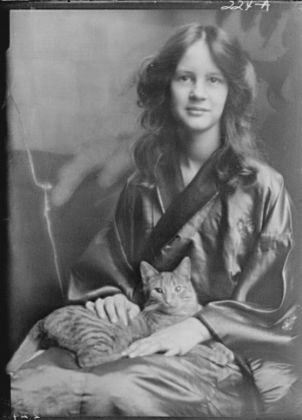
Figure 1 – Miss Jocelyn Stebbins (Mrs. Fletcher) with Buzzer the Cat, portrait by Arnold Genthe 1912 or 1913, from the US LOC and in the public domain because of its age.
Yesterday’s posting about Arnold Genthe and Buzzer the Cat poses what I like to refer to as a Mystery of the Belle Époque. It raises the question of exactly who was the spectacularly gorgeous Anna Holch. I suspect that there are students of Women’s Fashion Design who know the answer right away, but actually that is beside the point. There are few puzzles that I love more than a question like “Who was Anna Holch?” And this is because the Belle Époque is just remote enough from us that the embracing tentacles of the internet merely touch and brush against it.
I asked the question of Siri, and she got all confused; so you can see what I mean. The sophistication of the question requires more sophisticated searching or, and more to the point, more sophisticated information coding. But the significant point is that you can ask the question and there is a good chance that it is out there somewhere in cyberspace.
We have often spoken here of the magic of photography. That bewitchingly lies in its ability to hold a century’s old moment – a face – a smile-frozen forever. These are the faces of the nineteenth century and in a sense the ability to name the person and to understand a bit of their lives restores, or reanimates, that life. There is the arguable concept that the coming singularity will merge human and mechanical life, thus rendering it immortal. At least superficially, photography has been doing that for 178 years. That is, it gives immortality through entirely mechanical means. I would suggest that the marriage of photography and the internet deepens or extends this immortality. “So long as men can breathe, or eyes can see, So long lives this, and this gives life to thee.” It is as if the effects of the singularity diffuse, seep, and move backward in time.
A beautiful age filled with beautiful people, and that illusion is an important part of the magic. This was the time of our grandparents and great grandparents. I have a portrait on my office wall of my grandmother taken in 1911; so contemporary with Miss Holch’s portrait. Like Anna my grandmother was young and beautiful. I remember her as a sweet old lady, but the silver gelatin reanimates her and returns her to youth. Like H. Rider Haggard’s Ayesha she is reborn.
What of Anna Holch? Women of the time typically took their husband’s names. And if I am correct Anna Holch rapidly became Mrs. (or Madame) Tappé after marrying fashion designer Herman Patrick Tappé. Anna Holch was the leading hat model of her day. Rather clever of Genthe to pose her with a mere head-band, don’t you think? According to the Shelby (Ohio) Historical Society:
“He was the first to use models in his business. One of the girls was Anna Holch. She was known throughout New York City as ‘the beautiful Anna.’ She accepted his proposal for marriage, but Tappe wanted to time the announcement to gain maximum effect. He hosted a grand ball at the armory in Sidney in December of 1918 to celebrate the end of the First World War and announce his engagement. Over 600 people attended the social event of the season. … Local folklore has it that Herman later redecorated some of ‘The Chimneys’ in blue to match the striking blue eyes of Anna.
Over the next two decades, with Anna at his side, Herman Tappe became the rage in ladies’ fashions. In a book entitled The Ways of Fashion, author M.D.C. Crawford hailed Tappe as a “designer of creative imagination and authority,” who “for a generation has been recognized as an artist in costume by the most discriminating fashionables in the United States.” Crawford credited him with being the first American designer to gain international fame.”
So at least this little mystery from the Belle Époque is solved. But there are a couple more that I would like to consider, but those for another time. There is at least one more picture of Anna Holch by Arnold Genthe, but it lacks Buzzer; so in my opinion is not as interesting. As a result, I thought that a more fitting ending for today (although it could spark another mystery) is a photograph by Genthe of Buzzer with his companion Miss Jocelyn Stibbens (later Mrs. Fletcher) created in 1912/13.

I have done a significant amount of research on Herman Patrick Tappe and by association, Anna Holch. If you want any additional personal information, feel free contact me and I can help in any way I can.